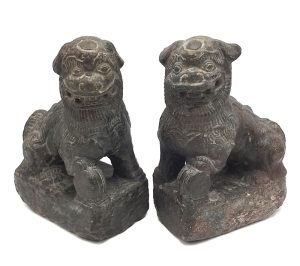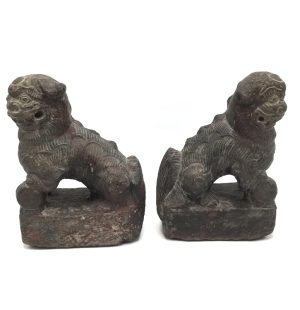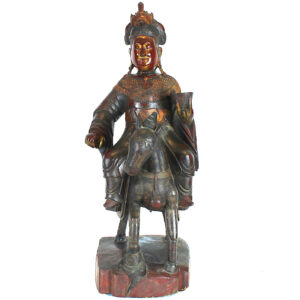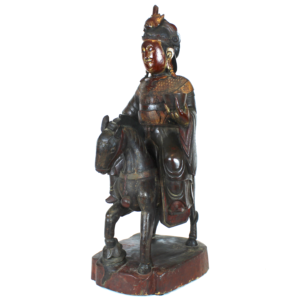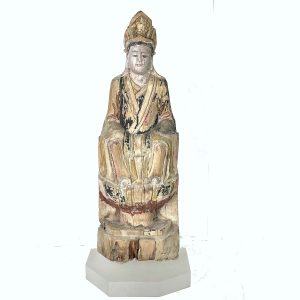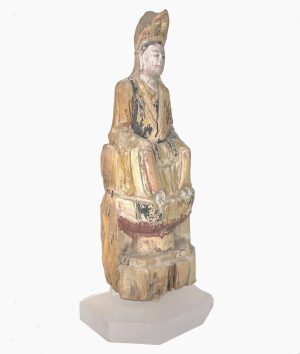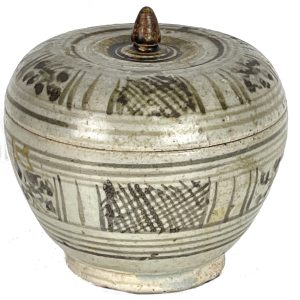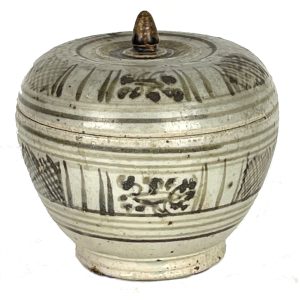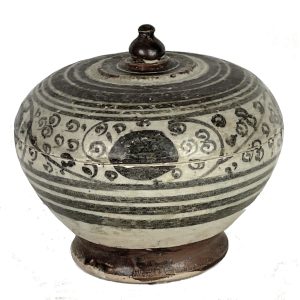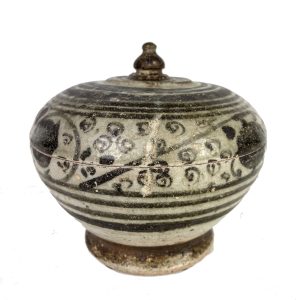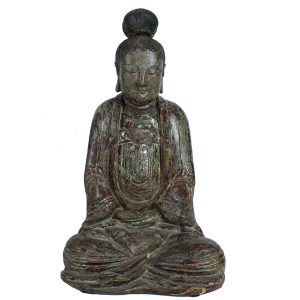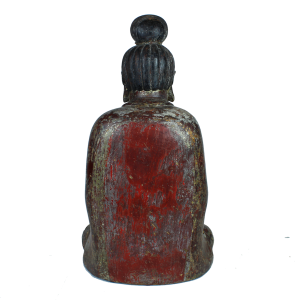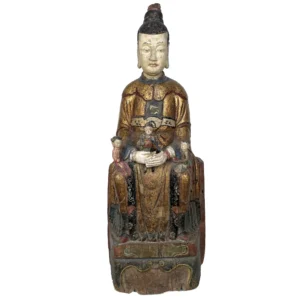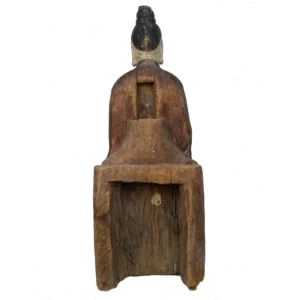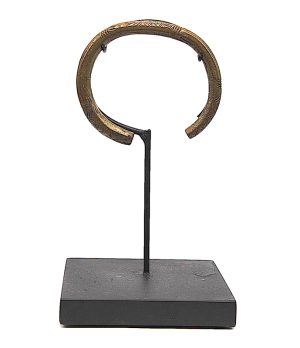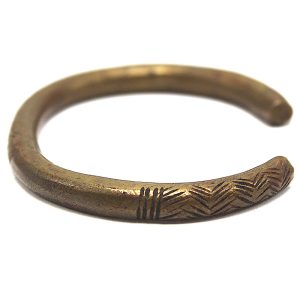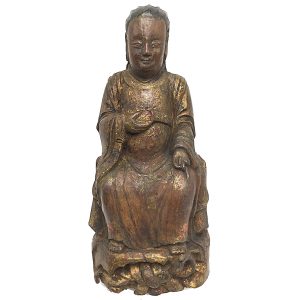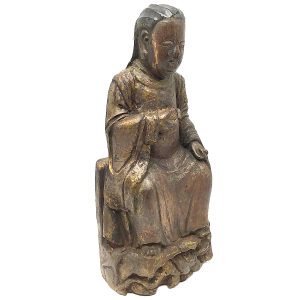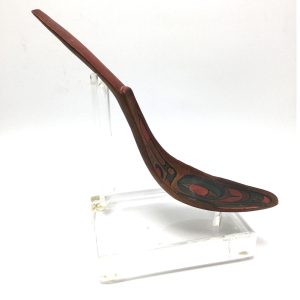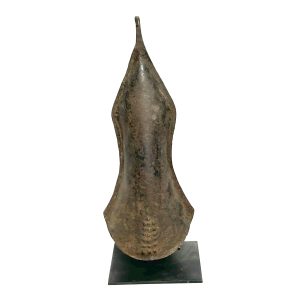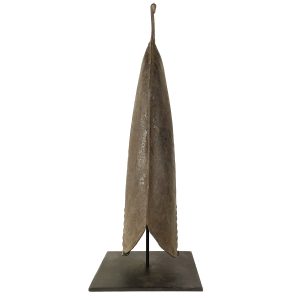Showing 337–348 of 430 results
-


$695.00
H: 8” W: 5.5” D: 3.25” | SOLD
This is a really great pair of stone small fu lions with lots of character, humor, and detailed carving. Each of these very joyous creatures has open mouthed smiling faces with radiant eyebrows and tufts below their chins, scalloped manes and bushy tails. Carved from one piece of a blackish hard stone they could easily withstand additional wear of the elements in a garden. Pairs of fu lions like this belong in the home of people who appreciate spirituality and wish for happiness and fortune along with a touch of wit and whimsy.
-
Sale!


$3,750.00 Original price was: $3,750.00.$2,900.00Current price is: $2,900.00.
The syncretic Queen Mother of the West is revered as one of the most significant of the female Taoist deities with a large Buddhist and Popular Religion following. She was the first female deity to both have “attained the Tao” and be represented in Chinese art. Her immeasurable powers include her complete control over life…
-


$1,375.00
SOLD | H: 23.25″ W: 9.25″ D: 6.5″
This Queen Mother of the West, the highest ranking female Taoist deity was probably displayed as a pair along a statue of Guanyin, the most significant Buddhism female (Guanyin on a Lotus Pedestal (16206B) highlighting the importance and similarity of these revered female images Like the Guanyin, the Queen Mother’s delicately carved face has half closed eyes, serene composure mouth with a hint of a smile, which is more Buddhist than Taoist. Her headdress, centered by her iconic phoenix, rests under a hood extending to her shoulders and back. She wears a high collared three-layered Taoist robe, her hands covered by a ritual cloth.
-
Sale!


$3,600.00 Original price was: $3,600.00.$2,900.00Current price is: $2,900.00.
Ht: 22” W: 8.25” D: 10” | CALL 213-568-3030 OR EMAIL [email protected] FOR SHIPPING.
Magnificent joyful Queen Mother of the West radiant smile, regal jewelry and exquisite attire and striking headdress with phoenix symbolizing the sun. She holds a cup with elixir of immortality, fingers in Taoist karana mudra to cleanse and purify and emanate energy to rid obstacles and unwanted energy.
-


$295.00
Ht: 4.25” Dia: 4.625” | SOLD
Produced in Thai kilns in the 14th to 15th centuries, Sawankhalok glazed stoneware lidded bowls were distributed through southeast Asia along with a variety of larger and smaller items. Lidded bowls like this were used to store many things, especially spices, powders and cosmetics, betel nut chewing materials, and medicine. This bowl rests on a thick foot, has a lid with a brown lotus bud handle and covered with decorative panels of underglaze brown crosshatch and vegetal scrolls.
-
Sale!


$325.00 Original price was: $325.00.$295.00Current price is: $295.00.
Ht. 4.75 Dia 5.25″ | SOLD
Produced in Thai kilns in the 14th to 15th centuries, Sawankhalok glazed stoneware lidded bowls were distributed through southeast Asia along with a variety of larger and smaller items. Lidded bowls like this were used to store many things, especially spices, powders and cosmetics, betel nut chewing materials, and medicine. This bowl rests on a thick foot, has a lid with a brown lotus bud handle and covered with decorative panels of underglaze brown crosshatch and vegetal scrolls.
-


$3,375.00
This exquisite 18th-century statue of the Bodhisattva Guanyin is seated in serene meditation. She is a beautiful young woman, unpretentious yet elegant with smooth, gentle flowing lines that create an air of peaceful spirituality. Every strand of her hair and bun is carved with definition, and in perfect order. The original polychrome and lacquer finish has transformed into a glowing silver hue with a soft patina.
-


$6,500.00
H: 43″ W: 15″ D: 9.75 | SOLD
This large rare vibrant carving is the Taoist Deity of fertility Niangniang (“The Maiden Who Brings Children”) is often confused with Songzi Guanyin. Represented as an empress like figure, she glances serenely at 3 diminutive children, 2 males and a female extending their arms for protection. Stunning and peaceful, it is covered with gold highlights with intricate details.
-


$110.00
SOLD
Manillas were commonly used by the Yoruba in the Coastal regions of Nigeria and along the Niger River. This thin simple round C-shaped manilla is decorated with incised linear designs on the outer round surface: it is centered on the top with parallel zig zag lines between a set of four parallel indentations which frame it. Each end also has zig zag indented striations. Simple, yet elegant, the bracelet is in very good condition, with normal wear, and pitting that verify its age and use. It comes with a wood metal stand.
-
Sale!


$595.00 Original price was: $595.00.$395.00Current price is: $395.00.
H: 12″ W:5.6 ” D:4″ | FREE SHIPPING WITHIN CONTINENTAL U.S.!
Zhenwu, the True Warrior, Perfected Warrior or Northern Emperor was one of the most popular TaoistDeities in the Ming and Qing dynasties known as protector of the state and the imperial family. His feet here rest on a pedestal over a turtle with a lifted head and a snake curled around his shell. Among the many interpretations this represent beings over whom he presided including both celestial officers under his command, [and] former demons that were conquered by him. This is a fascinating carving symbolizes trusted strength. and power.
-

$630.00
A potlatch means “to give away” or “a gift” and is a traditional feast central to many cultures of indigenous peoples of the Canadian Pacific Northwest Coast including the Haida tribe who have existed for over 17,000 years and currently inhabit Northern British Columbia, Pacific Northwest United States, and Southeast Alaska. Its main purpose is…
-


$395.00
H: 21″ W: 8″ D: 4.75″ | FOR SHIPPING INFORMATION CONTACT US AT 213-568-3030
This traditional African hammered iron gong is elegantly shaped like a flaring bell. Heat riveted, a forging process joining two metal pieces together, it was made by Congolese tribal people. Made with 5 parallel lines of 5 decorative round bulges on both sides, it was often held using a raffia handle and beaten using sticks covered with rubber at its end. Originally a ritual instrument, they were also beaten to call members of special restricted societies to meetings and were a symbol of wealth, prestige, and influence.
End of content
End of content

